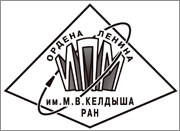|
The study of interhelical angles in pairs of helices in protein molecules
D. A. Tikhonov, L. I. Kulikova, A. V. Efimov
Abstract:
In this paper a statistical analysis of distributions of inter-helical angles in pairs of consequtive and connected $\alpha$-helices in spatial structures of proteins are presented. A number of rules for selection of the helical pairs from a set of protein structures obtained from Protein Data Bank (PDB) are developed. The set of helical pairs has been analyzed for the purpose of classification and finding out the features of protein structural organization. All the pairs of connected helices are divided into three subsets according to the criterion of crossing of projections of the helices on parallel planes, which pass through the axes of the helices. It is shown that the distribution of all the types of helical pairs, whose projections do not cross each other, covers almost the entire range of inter-helical angles. The distribution has a single minimum which is close to right angle. Most pairs in this set constitute helical pairs consisting of $\alpha$- and $3_{10}$-helices, and most pairs with the crossing projections of helices are helical pairs formed by two $\alpha$-helices. It is also shown that a great amount of the pairs of connected $\alpha$-helices has accute angle ($20^\circ\leqslant\phi\leqslant60^\circ$) between the axes of the helices. The distribution of all the types of helical pairs depending on the length of the inter-helical connections is also analyzed. It is shown that the structures with short connections occur most often in all the subsets.
Keywords:
structural motifs of proteins, point model, helical pairs, angle
between the axes of the helices.
Citation:
D. A. Tikhonov, L. I. Kulikova, A. V. Efimov, “The study of interhelical angles in pairs of helices in protein molecules”, Keldysh Institute preprints, 2018, 176, 25 pp.
Linking options:
https://www.mathnet.ru/eng/ipmp2535 https://www.mathnet.ru/eng/ipmp/y2018/p176
|

| Statistics & downloads: |
| Abstract page: | 130 | | Full-text PDF : | 36 | | References: | 28 |
|




 Contact us:
Contact us: Terms of Use
Terms of Use
 Registration to the website
Registration to the website Logotypes
Logotypes









 Citation in format
Citation in format 